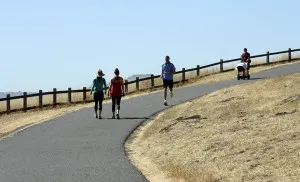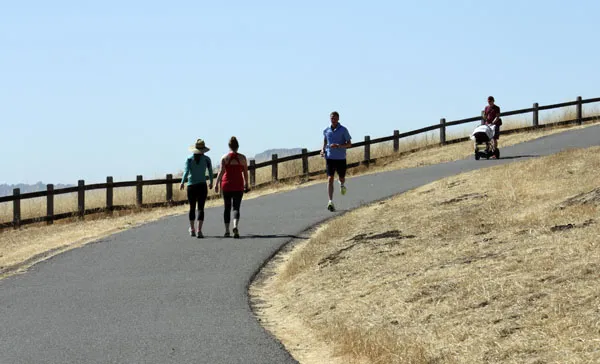
When I’m up where I can see the entire bay, I notice the silence. There is no iPod music or angry drivers searching for parking up here. There are no dogs barking or babies crying.
Instead, there’s the hum of insects emanating from the hay-colored fields, the swish of wind and light chatter that floats through the air. It’s not complete silence, but the sounds blend together to create a quiet atmosphere. And it is the resulting orchestration of simple harmonies that reminds me that I’m standing on one of the lesser-known symbols of Stanford University.
A Palo Alto local, I walk the Dish hiking trail every Saturday. Today isn’t Saturday, but the sloping path at the very beginning of the hike, guarded on both sides by rows of tan plants, remains the same. This hill is my least favorite part of the walk and my calves ache and pinch by the time I reach the top of the hill.
The Dish, built by the Stanford Research Institute (SRI) in 1966, is a radio reflector antenna built for the U.S. Department of Defense to study the atmospheric composition. It served different purposes in the past, like studying spacecrafts, but remains in use today for academic reasons. The reason walkers can see it from almost any point on the trail is because it’s huge: 150 feet in diameter.
In front of me, a young couple stops mid-jog to take a picture of a squirrel reclining in the shade of a fence. Although the squirrels are adorable, I’m not excited when I see them. Because they’re everywhere, I can always expect them to fearlessly run across the trail and chew the plants growing on the sides of the road whenever I visit the Dish. Once, I tried to keep count of how many of these rodents there actually were. One. Two. Three. I stopped when I realized that I still had half the trail to finish and I had already reached 80.
I’m a little more surprised when I notice a white heron standing serenely by the trail. But seeing the animals is all part of the experience of walking. On my many visits, I’ve seen white and blue-grey speckled herons, predatory birds, lizards, hares, a coyote, a deer and ground squirrels — so many squirrels. I’ve even been traumatized by a dead snake.
The only animal I’ve never seen is a mountain lion, even though the large warning sign reminding walkers and runners of their existence nearby is the first thing that greets me at the gate to the trail. I suppose that’s a good thing.
Even without the animals, the trail is one of the most picturesque places around Palo Alto, especially when I reach the top. Today, I peer down and see Hoover Tower stabbing through the sea of red buildings and the bay, adorned by clouds. It’s fit for a postcard. Around me, the air is smooth and refreshing, even though the midday sun is growing stronger.
After I reach the top of the incline, the road grows flat, making it perfect for conversation. My friend and I chat about our summer vacations (she went to the Arctic then South Carolina; I went to New Zealand) as we stroll down the path. Joggers, sweating and breathing heavily, thunder by.
Reaching the Dish marks, for me, the halfway point in the trail. Not everyone would call the actual Dish artistic, but I wonder if people appreciate the history behind what they walk by. For years, I didn’t. Panting, I’d give one or two glances at the hulking blue and white machine and then keep walking. But in retrospect, it deserved more respect from my young self.
In May 2000, former Stanford President Gerhard Casper released a statement detailing conservation plans for the Dish. In 2010, the plan was refined to conserve at least five species native to the area surrounding the trail, including the California tiger salamander. Currently, the Dish is undergoing both habitat conservation and restoration of native flora. Even so, I don’t notice anything that distracts from the natural beauty of the trail.
Toward the end of my walk, surrounded by a breathtaking view that includes both Stanford architecture and the natural environment, I cannot find the words to express myself. But at that moment, a little girl walking past me says what is really just on the tip of my tongue.
“You were right!” she crows to a woman standing next to her, bending down and looking around. “You can see everything from up here.”
And in a way, she’s right. Up here, there’s a view, an environment, a community, a history.
